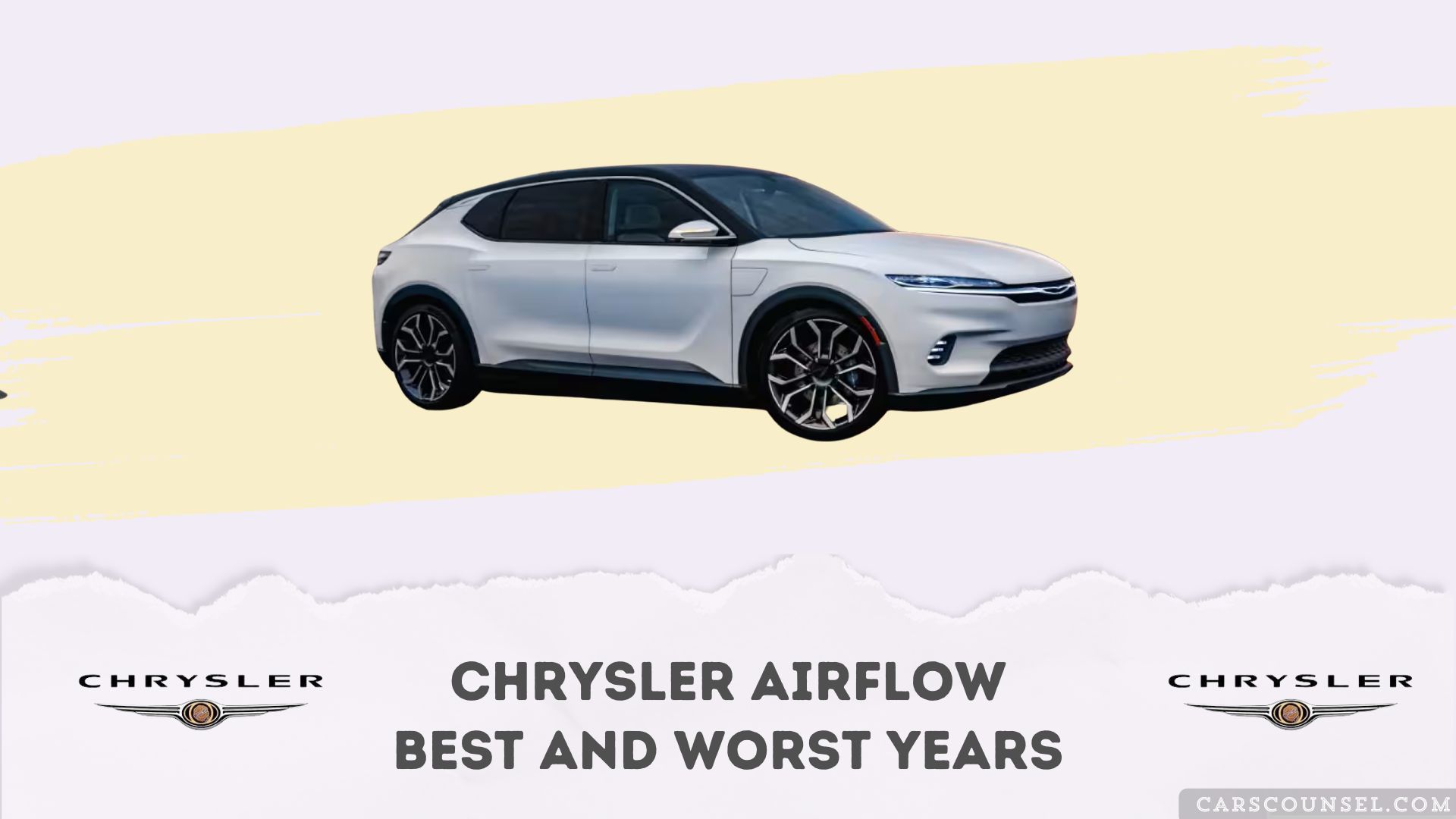As you delve into the highs and lows of this iconic vehicle, you’ll discover how its pioneering design and cutting-edge features made 1934 to 1936 the best years for the Chrysler Airflow. With its aerodynamic shape, all-steel construction, and rear seat forward of the rear axle, it was a game-changer.
But what led to its downfall, and how did its worst years, 1937 to 1939, impact the automotive industry?

Quick Navigation
Key Takeaways
- The 1934 Imperial Airflow Limo showcased its unique curved shape in its brochure, highlighting its innovative design ahead of its time.
- Early models had faulty manufacturing, leading to parts coming loose at 80 mph, which damaged consumer trust and made the worst years.
- The Airflow’s commercial performance was abysmal, with traditional models outselling it 2.5-to-1, ultimately leading to its discontinuation in 1938.
- The 1936 Toyota AA and Volvo’s PV 36 Carioca adopted the Airflow’s groundbreaking design, making it a true pioneer in the industry.
- Despite its setbacks, the Airflow’s innovative features set a new standard for modern vehicles, paving the way for future design developments.
Chrysler Airflow’s Design Inspiration
When Carl Breer gazed upon a V formation of geese in flight, he was struck by the aerodynamic advantages of streamlined design.
This inspiration led him to suggest a radical new shape for the Chrysler Airflow.
You’ll find that the Highland Park Site built a wind tunnel to study which automobile shapes would be most efficient, resulting in the Airflow’s development.
The need for aerodynamics influenced the design, giving the Airflow its sloped rear that concealed the spare tire.
The curved shape of the 1934 Imperial Airflow Limo was showcased in its brochure, highlighting its unique design.
Innovative Features Ahead of Its Time
The Chrysler Airflow’s innovative features set a new standard for the automotive industry.
You’ll notice its streamlined body, which reduces wind resistance and enables more even weight distribution.
The car’s design was influenced by Carl Breer’s inspiration from geese in a V flight pattern, military planes, or lighter-than-air airships.
A wind tunnel was built at Chrysler’s Highland Park site to study efficient automobile shapes.
The Airflow’s unibody construction achieved rigidity with less weight, and front-opening rear doors aided entry into the back of the 1934 Airflow.
Its innovative features were truly ahead of its time.
Setbacks and Controversy
As Chrysler’s innovative design began to gain traction, a series of setbacks and controversies threatened to derail the Airflow’s success.
You see, early models had faulty manufacturing, leading to parts coming loose at 80 mph, which damaged consumer trust.
General Motors launched an advertising campaign, labeling the Airflow design as unsafe, further hindering sales.
Sluggish sales and loss of market share followed, ultimately leading to its discontinuation in 1938, with traditional models outselling it 2.5-to-1.
Unfortunately, the negative perception surrounding the Airflow overshadowed its innovative features.
Legacy and Influence on Modern Vehicles
Chrysler’s pioneering Airflow design paved the way for future generations of vehicles, leaving an indelible mark on the automotive industry.
You can see the Airflow’s influence in the 1936 Toyota AA and Volvo’s PV 36 Carioca, which adopted its groundbreaking design.
The Airflow’s innovative features, such as all-steel construction, rear seat forward of the rear axle, and aerodynamics, set a new standard for modern vehicles.
Its engineering advances, including independent front suspension and leaf springs, are still incorporated in many cars and SUVs today, making it a true pioneer in innovative design.
Commercial Failure and Discontinuation
Despite its pioneering achievements, you’re faced with a stark reality: the Airflow’s commercial performance was abysmal. Sales were sluggish, with traditional models outselling the Airflow 2.5-to-1, leading to its discontinuation in 1938.
The radical design and features were too far ahead of their time, and consumers were slow to accept them.
| Year | Sales | Reason for Poor Sales |
|---|---|---|
| 1934 | 10,000 | Faulty manufacturing, unsafe at 80 mph |
| 1935 | 20,000 | Discrediting campaign by General Motors |
| 1936 | 15,000 | Consumers slow to adopt radical design |
| 1937 | 10,000 | Traditional models outselling Airflow |
| 1938 | 5,000 |
The Most Attractive Airflow Models
You’ll find that the 1934 CV Imperial Airflow and 1937 C17 Airflow Coupe stand out as the most attractive Airflow models.
The 1934 CV Imperial Airflow’s radically sloped rear deck and 128-inch wheelbase make it a notable design.
Meanwhile, the 1937 C17 Airflow Coupe’s longer hood and conventional grille balance its longer passenger compartment, creating a visually appealing package.
1934 CV Imperial Airflow
The 1934 CV Imperial Airflow Coupe stands out as the most attractive Airflow model, boasting a radically sloped rear deck which cleverly concealed the spare tire.
You’ll notice its 128-inch wheelbase, five inches longer than the 1935 C1 Airflow Coupe, making its hood appear proportionate.
Although the hood seems short, the wheelbase and passenger compartment create a visually appealing Imperial coupe.
Its radically sloped rear deck surpasses the bulky sedans, solidifying its position as the most attractive Airflow model.
1937 C17 Airflow Coupe
Seven C17 Airflow Coupes stand out as the most attractive Airflow models, boasting a unique blend of style and functionality.
You’ll notice the 1937 C17‘s body is more attractive than the 1935 C1 coupe, with a grille that outshines the 1935 C1’s. Its longer hood is better proportioned than the CV Imperial’s, and its aerodynamic design was influenced by the original Airflow’s radical sloped rear, which concealed the spare tire.
With only 4,600 units made, this rare Chrysler Airflow Coupe is a valuable find among car enthusiasts.
Impact and Lasting Legacy
As you delve into the Airflow’s impact, you’ll notice that its innovative design principles, such as all-steel construction and aerodynamics, have had a lasting influence on the automotive industry.
You’ll see that these groundbreaking design principles have been adopted by other manufacturers and continue to shape modern car design.
The Airflow’s legacy can be seen in contemporary cars, where its influence is still felt.
Airflow’s Lasting Influence
While Chrysler’s Airflow experiment ultimately failed to enthrall the market, its innovative design and engineering features didn’t go unnoticed. You’ll find that other manufacturers, like Toyota and Volvo, were inspired by the Airflow’s design. Its groundbreaking benefits, such as aerodynamics and a rear seat forward of the rear axle, were evident. The Airflow’s impact is clear in the table below:
| Feature | Description | Adopted by |
|---|---|---|
| All-steel construction | Improved safety and durability | Toyota, Volvo |
| Rear seat forward of rear axle | Increased passenger space | Volvo, others |
| Innovative design | Streamlined body style | Toyota, others |
| Aerodynamics | Improved fuel efficiency | Many manufacturers |
| Historical significance | Preserved in museums and exhibitions | Car enthusiasts, museums |
Revolutionary Design Principles
The Chrysler Airflow‘s pioneering design principles not only influenced its contemporaries but also left a lasting impact on the automotive industry.
You’ll notice that other manufacturers, like Volvo and Toyota, borrowed design elements from the Airflow.
The Airflow’s groundbreaking benefits, such as all-steel construction, aerodynamics, and a rear seat forward of the rear axle, were eventually adopted by other manufacturers.
Its forward look and airflow models paved the way for future design developments, making it a true pioneer in the industry.
When looking at performance cars, make sure to check out our guides on models like the Chrysler 200, Chrysler 300, Chrysler Aspen and Chrysler Crossfire. Knowing which model years to target and which to avoid is crucial. Our expert reviews break down these models, providing insights into the years that are celebrated for their engineering excellence and driving satisfaction, as well as those that are best to avoid due to potential issues.

